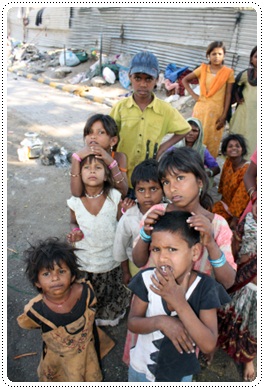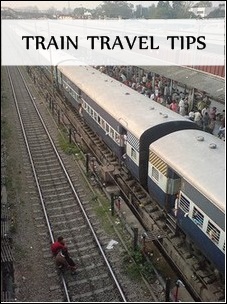
| ||||||
|
India Poverty
"About Poverty in India
|
||||||

|
Absolute poverty is what you see on television and commercials - when they show skinny children from the African Horn. According to World Bank's last threshold, the absolute poverty line is $1,25 per day.
In other words, if a person is living on $1,25 or less per day, that person is living in absolute poverty.
Poverty can be an evil circle. In India and many other Asian countries, giving birth to many children is for them considered as a safety network. Hopefully the children will get a job and provide the parents money and shelter in the future.
It's also suggested that poor people give birth to many children as possible because they know that the survival rate is lower (for instance low survival rates in slums).
They want to maximize the chance of having children who will actually grow old. If the government won't help them, then they will help themselves in other ways.
But in reality, the Indian population is growing rapidly.

Figures from World Bank show that India's GDP (Gross domestic Product) has risen from 2005. This means that there has been an economic development in the country. And the number of poor people has been reduced.
Despite the fact that India it a strong competitor in world economy, the poverty in eight Indian states correspond to 26 of Africa's poorest countries (Human Development Report 2010). There are about 421 million Indians who live in these eight states. 69% of the Indian population don't have access to sanitary equipment. And that's just the tip of the ice berg.
What's wrong with this picture? There's economic development in India, but still hundreds of millions are poor. What happens to the income?
So what causes the poverty in India?
The reasons are many, and to point fingers would be difficult and a little unreasonable.
Some scholars have claimed that rapid population growth is the core in poverty. But why are these poor people giving birth to so many children? More than they could economically handle? I would say, because they are poor.

One of the considered factors in Indian poverty is corruption.
According to Transparency International, which is an anti-corruption organization, India was ranked as no 87 on the 2010 corruption list. There are 178 countries accounted for in these results.
India's result was 3,3 points. A country that has no corruption gets 10 points. In other words, there's a lot of corruption in India. And there's of course hidden statistics as well.

|
When I say international influence, I mean multinational companies or corporations (MNCs), or also called transnational companies (TNCs).
According to lectures we had on 'globalization', TNCs and their subsidiaries stand for 2/3 of global trade. Yep, that's right.
The poverty in India affects both rural and urban areas in the country. These two are connected and I will tell you how.
When GMO (= gene modified organisms) was introduced in India, it was promised that this would solve the starvation problem. It is claimed that TNCs only research plants that have economic value. Cash crops is one problem.
Over the years thousands of farmers committed suicide.
Access to expensive GM-seeds requires fund and investments. Vandana Shiva, a well-known physicist and activist, claims that companies in India have taken patent on GM-seeds. The patent prevents farmers from saving seeds from year to year because it's not allowed.
Some farmers cover the purchase by taking out a loan. Usually the profit will not cover the loan and the interests. The problem is when crops are ruined by floods or drought. The food security is worsened when the farmers can't pay back the loan.

In 2006 a debt crisis led to the suicides of 17,000 Indian farmers. They drank spray chemicals. The debt crisis was caused by a combination of high interests, lack of insurance and crops failure.

When the crops have failed and the farmer didn't commit suicide, he and his family will migrate to urban areas to get a job.
The migration makes it harder to keep up with the growing urban population, and one consequence is that there's not a job for everyone. This is where urban poverty comes into place.
If they do get a job, some Indians work under terrible conditions. Risky factory jobs, low income and long hours. To maximize the chance of getting food on the table, many of them will send their young children to work. I don't need a doctor degree to say that this type of work shortens their life span.
Don't get me wrong, empirical evidence shows that some factory workers in India appreciate to work even though the working conditions are bad.
The job gives them a sense of dignity and self-respect.

A city like Mumbai has expanded a lot over the last decades. The poor people in Mumbai live in the slums where the sewer is running freely in their slum streets, and where large families have a living space of only a few square meters.

The debate on starvation has focused on increased food production to a growing population, but we must not forget that distribution of existing food is also an essential matter.
Distribution has always been a problem. If everyone on this planet shared everything they had, I think that would solve much of the poverty issues.
These statistics show that even though India has a strong economic development, this money growth hasn't trickled down to everyone in the population. That's for sure.
I'm a bit of a pessimist on this matter. I believe that to eradicate the poverty in India and globally, you have the change the attitude and policy of the policy-makers: the TNCs. They are the guys with the money, and that's why everyone else is bowing their head for them.
A quote that suits for this matter: "It was only business, don't take it personal".
Foreign aid helps to a certain extent, but developing countries shouldn't rely on it forever. Without accusing any countries, aid might in some cases function as a 'sleeping pillow'.
The country that receives aid might get lazy and stop working on its internal problems, because hey... they're receiving money, right?
And even if aid is aimed at distribution to the helpless, it's not always the case. As I mentioned earlier, corruption is a large and ever-lasting problem in all countries, but to different degrees.
Right now, many of the industrialized countries are fighting for the remaining natural resources we have on this planet. What happens when we don't have anything left?
Return to top of India Poverty
Do you need help with your itinerary for India?

|
Don't know how to travel around in India?
Map Your Adventure India is a step-by-step guide on how to create itineraries.
I will help you create a good itinerary - one you'll never forget.
Search this site
Train Travel in India



Learn Hindi
Traveling in India? Learn useful Hindi phrases for free!
 Learn Hindi on your iPod
Learn Hindi on your iPod
Connect with
Backpacking Tips Asia


